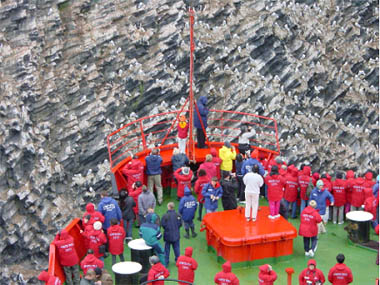|
DESCRIPTION
Keywords
Problems and conflicts of high-latitude tourism.
Recently, European high-latitude tourism has become
more and more popular. Due to economical problems in
Russia even the largest icebreakers of the world have
started to be involved in the Arctic tourist cruises.
High-latitude coastal areas are attractive for tourists.
The Russian sector of Europe may be subdivided into
two main groups:
- Coasts of the Barents and the White Seas.This
is more or less inhabited land. However, basic roads,
hunting houses or deserted settlements of previous
times exist here.
- High-latitude archipelagos. Cruises
to Franz Josef Land and the Nova Zembla islands may
include even a visit to the North Pole on nuclear
icebreakers (e.g. Yamal) or helicopters (sometimes
- with last kilometres on skies). These areas have
no permanent population. Infrastructure here is completely
absent or undeveloped.
|
|
|
The main problems
Conflicts concerning the high-latitude tourism
are as follows:
Infrastructure inadequate. Visiting
the so called Arctic deserts, tourists sometimes cannot
behave in a sustainable way even if they wanted to.
For example, absence of specially constructed planked
footways on some Arctic islands (see below) leads to
the trampling down of the thin vegetation cover. This
worries tourists but they cannot avoid or change the
situation. Furthermore, infrastructure development is
not projected, since the few tour operators dealing
with Arctic tourism are not interested in large investments.
Nobody can force them since there are no controlling
entities in the area. Another example is the Franz Josef
Land, legally speaking a Protected Area but permanent
protecting service is absent here. So, the tourism in
the area is actually uncontrolled. Formally, special
observers representing the regional nature protection
authorities are included into the staff of the Arctic
cruises. Yet, those people are usually not qualified
for the job (it is not their main speciality) and they
depend on the tour organisers because the firm provides
them with services on a level with all tourists (including
feeding in the high-class restaurant) free of charge.
Neglecting of natural processes. In high-latitude
areas life is highly concentrated on small sites (vegetation,
bird colonies, seal-rookeries, walrus shore and ice
grounds). These sites are both the most attractive for
tourists and for nature. However, guides frequently
visit them in the course of foot or boat excursions.
Moreover, such sites are specially visited during the
helicopter excursions from the tourist icebreakers.
Tourism development is not planned well. Activities
are planned only for short-term perspective.
|
Insufficient environmental knowledge of tour
providers. Icebreaker based excursions to bird
colonies located on coastal cliffs are not harmful while
helicopter excursions are extremely dangerous to nestlings
and young birds. Pursuit of walruses or polar bears
on motorboats with tourists in aspiration to see them
from up close so they can make better photographs leads
to stress for the animals. However, that is exactly
the attraction for which the tourists pay good money.
So it is only partly insufficient environmental knowledge
of tour providers and to a greater extent it is their
tendency to please the tourists.
Low level of education. Environmental
knowledge of tour operators and guides working in the
Arctic is not always high enough. Usually they have
no special professional training and certification.
A Special Code of Conduct for the Arctic Coasts (for
both tour organisers and tourists) is absent. Even if
a tour organiser does not possess all required documents
nobody controls his activities.
Carrying capacity neglected. High Arctic
vegetation is extremely vulnerable and rehabilitates
extremely slow. Visiting of high-latitude areas by large
quantities of tourists leads to the impact of vegetation
(e.g. some islands of the Franz Josef Land Archipelago
are visited by approximately a thousand tourists during
summer).
Deterioration of natural resources. Environmental
deterioration in the Arctic environment may be caused
by the use of inadequate transport (teams of hunters-tourists
are transported to the places of hunting on caterpillar
tractors). In many cases that causes disturbance or
even destruction of the permafrost layer abundant in
the Arctic, further landscape erosion and consequent
ravine formation.
|
|
Actors, location and Time
The Agency VICAAR ( "Victory in the Arctic and Antarctic
Research") was founded in 1991 in St. Petersburg. The
director of the agency is Dr. Victor Boyarsky, a famous
polar explorer, member of the International TRANSANTARCTICA
Expedition, the International Arctic Project Expedition,
having crossed the Arctic Ocean with dog-sled and canoe
from the Russian Arctic via the North Pole to Canada.
The personnel consists of the professional scientists
and polar explorers - acting as logistics supervisors
and lead guides and creators of the programs.
In tourism, VICAAR focuses on the educational aims
and preservation of the beauty of nature. It gives clients
time and opportunity to enjoy, appreciate and learn
about the unique and fascinating Wild Nature regions.
Its programs are aimed at providing maximum safety for
all participants with minimum impact on the environment.
VICAAR intends to develop this form of tourism in a
more sustainable way.
Approach
The activity in the field of the sustainable Arctic
tourism development is not specially financed. To a
greater extent it is the team mentality which is moving
VICAAR towards an environmentally friendly way of behaviour.
|

|